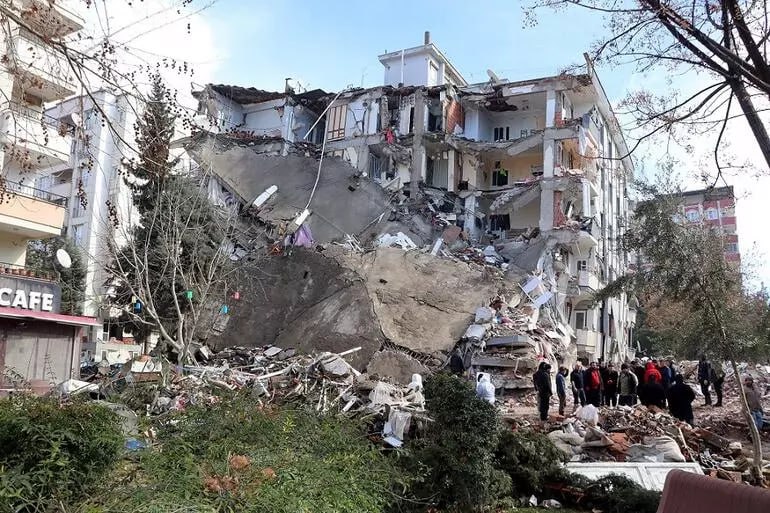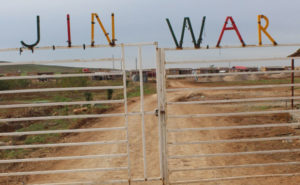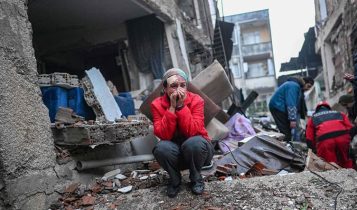On the 6th of February, the earth trembled abruptly and sent us a message. The question is: what are we willing to hear? We want to look at this tragic event through the eyes of Jineolojî, the science of women and life.
During the earthquake in Kurdistan (Bakur and Rojava), Turkey and Syria, at least 51,000 people lost their lives, many more were wounded and lost their homes and beloved. With this article, with warm greetings from the Andrea Wolf Institute, we want to share our tenderness and strength to all the people affected by the earthquake. Our hearts and minds are with all of them.
When we follow the mainstream news, we see that the earthquake is projected as a “natural tragedy”. They transmit the idea that nature is an external and dangerous entity. An entity that is against us and therefore one which we need to be protected from. If we rise our eyes and expand our gaze, we will realize that the earthquake is not about cold numbers and individual stories detached from political and social reality. We would see that the people most affected by it are those who live in big cities; especially in impoverished neighborhoods, accumulated in high and unstable buildings, lacking resources and infrastructure. We would realize that many of them have been previously evicted, forced to leave their land and losing the possibility to live there.
After the earthquake. the states are pretending to solve the problems that they created in the first place. To understand this, the states need to be considered as part of the current dominant system, Capitalist Modernity. In this system, as defined by Abdullah Öcalan, the capitalist market system has become the dominant system in our societies. This system has spread worldwide and into almost all areas of life, measuring everything by its economical rather than by its ethical values. The companies and states – from Turkey, Syria, other states in the region, until Europe and the USA – are using the earthquake to strengthen their power and make profit. The earthquake has dismantled this problem of money-oriented projects and policies. During years, the corruption in the construction industry has led to fast construction and unstable buildings. This corruption is not an abnormal, but an integrated part of the system where money becomes more important than lives. A reality that becomes explicit with the collapse of those buildings. Another example are the new companies of cement that have been created to re-build the cities. Capital is always flowing to where it can extract the biggest profit.
With a face of humanitarian aid the states try to hide their bloody policies. Under these masks they rearrange the region according to their own interests. The Turkish state intensified the establishment of settlements in its occupied areas in Rojava, the northern part of current Syria. A clear and perverse example is the Turkish – Qatar agreement to create the so-called “City of Dignity” in Janders district. Under the excuse of rebuilding destroyed areas, they use the earthquake as an opportunity to continue expanding their occupation. They are uprooting the indigenous Kurdish and Alevis populations and let displaced people from other areas settle there. Furthermore, they are preventing help for people on the ground; pushing division and fragmentation by creating distrust and accusations of thieves; beating those who try to help and those who are crossing the borders; blocking every help coming from society; preventing the support from the Autonomous Administration of North and East Syria (AANES). These are just few examples of how the racist and fascist policies and practices manifest.1
Once more, women and children are the ones who are suffering most from the devastating consequences of the earthquake. Acknowledging that many children have lost their parents is heartbreaking. It is even worse when we get to know the intervention of the state. In many occasions the Turkish state allied with fundamental Islamic organizations to take the custody of the children. Following their interests they send them to orphanages where they will be raised under their control. An example are the Ismael Aga organization’s residences that has been publicly denounced to insult and abuse the children. Apart from the inhuman conditions, the indoctrination of Islamic fundamentalist mindset is also highly concerning. The lack of values and caring is also seen in neglecting the women and their necessities. In the news we can see very few women taking decisions or responsibilities. But when we step on the ground, women are more than present. From the woman baking bread, women organizing the donations to the woman that has opened her house to give shelter to those in need.
These images of people supporting – especially women – show that not everything has been lies and destruction. Among the dramatic situation, gestures of empathy, care and love have been present. Mutual support has expanded: from the families, the neighborhoods, friends in the region to all around the world. People self-organizing have proved once more the strength that we, the people, have. This proves the necessity to recover the trust in our capacities; the ability to reflect, overcome and solve problems together; the awareness of our interconnections; the relations and actions that put them into practice; the questioning of our real necessities and aims connected to life.
How do we want to live? What to we want to rebuild? Do we want to live a life according to nature around us and remember that we are a part of it? Or do we want to live a life against nature forcing damage and alienation? How were our ancestors living in balance with their surrounding? What are current examples? Why are so many people pushed to live in big cities? Are big cities a solution? How can cities be in harmony with nature? How can we organize in a real democratic way?
Instead of looking just at the moment, we need a long, historical and wide perspective to answer these questions. Namely, to go back thousands of years and look at the emergence of the state and its mentality. This allows us, on one hand, to not see it as a peculiar problem of some single men in position of power. On the other hand, it becomes clearer that talking about a “natural catastrophe” killing people hides the cruelty of the state and its mentality. When we dig deeper we find that the roots of the problem lies in the distinction between human and nature. A separation that lead to the establishment of power and a ruling class.
One of the oldest examples can be seen in the Gilgamesh epic written in the 2nd millennium BCE. Around that time Gilgamesh was probably the ruler of Uruk, one of the first cities in the Middle East. In the epic, Gilgamesh is described as a hero, who has performed many heroic deeds. He is described as an impetuous man. The citizens are forced to build the wall around the city and to realize other exhausting works. Concerning the women, Gilgamesh takes the “lord right” to rape brides on their wedding night. The inhabitants of Uruk finally call upon the Mother of all Goddesses to create a rival for Gilgamesh. When she hears the aim of the people, she creates Enkidu. This character lives freely in the forest among the animals, plants and all living beings. Enkidu is tamed by a prostitute woman, Shamat. They spend six days and seven nights and at the end Enkidu becomes a different man. She teaches him how to be “civil” and the ways of “civilization”. After this, the wild animals are afraid of him. From that moment onward, he will not live as part of nature anymore. Later on, Gilgamesh and Enkidu fight against each other. At the end, Enkidu acknowledges Gilgamesh’s superior strength and they become friends. Gilgamesh wants to continue having more fame and reputation. That’s why he proposes to his new friend to go and kill Chumbaba, the giant of the cedar forest. They end up killing the giant and many other gods of the forest. The goddess Ishtar wants to stop them but she does not succeed. At the end, Enkidu dies. In his last breathes he curses the woman that triggered the path of destruction. He is convinced that he should rather be grateful for everything. Gilgamesh, on his side, gets more afraid of his own death and continues his search for immortality. This epic is more than just a story, as mythologies are more than just stories. As much as today we use science to explain the world, in the time around 2,000 BCE, people used to give sense of the world through mythologies. In the figure of Enkidu we see how nature, and people living as part of nature, were either assimilated, in the ruling system, or destroyed. Gilgamesh on the other side, represents the “superior”, the “master”, the mentality of domination that does not only dis-attach from nature but also places itself above it. The Mother Goddess is also an other important character. During all the story she tries to defend and protect the nature and its creatures without a big success. All the attacks that she suffer represent the dis-valuation of nurture and care.
The story was written while the first cities, organized in an hierarchical way, appeared in the Middle East. The harmony of nature had been preserved through an animists belief. The consideration of our surroundings as sacred and alive entities, with soul, were in balance with life. As time passed, the cities started to arise. They were not determined to lead to power, but still little by little they favoured a life disconnected from nature. In the cities, the sacred started to be enclosed and limited to an elite in its temples. Nature turned into an entity separated from humans. The land, animals, plants and resources, became objects to conquer and posses. This was the base of the destruction of nature.
In this story we can find keys to understand the problem of the earthquake and beyond. It helps not only to understand the problem but also to look for solutions. Although money and material help is still needed, it is not enough. Neither is it enough to change our approach to nature in a superficial way. When we go deeper, we face and acknowledge the profound wounds that this earthquake has opened. There are grief processes lying in front of us. There is rage and sadness in all of us: the dead, the lack of support, the precarious living conditions, the hypocrisy and manipulation…
We also acknowledge and remark that the tragedy hasn’t been provoked by chance. And neither will this situation change by chance. That there is help to alleviate the earthquake damage is good. And it’s important that it is coming from all around the world. It reflects the international solidarity and humanity. But the question is – who and what are we going to support? Where are the help and the donations arriving? And as soon as the news are not focusing on the earthquake, what will we care about? If we do not pose these questions, we will perpetuate what is already happening. A large part of the donations are manipulated. The Turkish and Syrian state have continuously retained and appropriated the popular support. They have used a large variety of dirty mechanisms. One of them is the exchange of the popular organizations’ names on the trucks transporting aid goods with the names of radical Islamic groups. It is neither an insignificant nor a naive act. They attempt to give the image that self-organisation does not exist. There they strengthen the belief in the state and Islamic fundamentalism as if they were the ones protecting and helping.
That’s why we are willing to know and understand below the surface. To dismantle the state and the dominant mentality that suppress people and their lands.
Despite the continuous attempts, the states cannot erase popular self-organisation. We have seen – once more – that self-determination of the people works better than the existing state. That if we are willing and determined, we can create realities of our own beyond the states. This by itself is a big aim. The question is: who do we address for help and whom are we helping? We do not ask for a state to help, we are asking for the people to self-organise.
To step forward, we call for a deep reflection on how we live our lives. While remembering us as part of nature, together we can find real and practical solutions.
There will always be earthquakes, but we can make sure that in the future the damage will be less tragic. For this, it is not about building more and more high concrete buildings. Contrary, it is about building a life where we are connected with our surroundings and beyond. We don’t know the exact form of this path. But in history and the present, there are concrete examples that represent the horizon to walk through.
Indeed, we are writing this text from Jinwar, the women’s village in the AANES. A village, that is part of the women’s revolution. It was built up from below following the traditional way of building houses and being aware of the materials used. All the houses are facing each other in a circle, materializing the communal life. Next to the houses, there is a bakery, a vegetable garden, trees and medical plants. There is also ShifaJin, the healing center of women and children, which guarantees that the villagers can care about their own wellbeing. Jinwar is one example of building a self-sustainable life. It rises in a specific place, a specific moment and is embedded in a revolutionary process.
The earthquake calls for the emergency to find answers for the question all around the world: How and what do we want to build to walk through a communal and free life. To answer this question and revert the current situation, those silenced and undermined have to take the lead. The oppressed, especially women, who reserve, defend, and create values of freedom and community need to organize and combat the current destruction and dominance. Looking into the past, and looking to the future, we want to remind to collective courage to take the lead in our own hands.
1For further detail and development we reference to the statement from the Internationalist Commune of Rojava on the earthquake in Kurdistan, Syria and Turkey.





